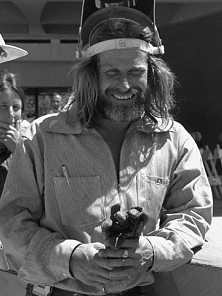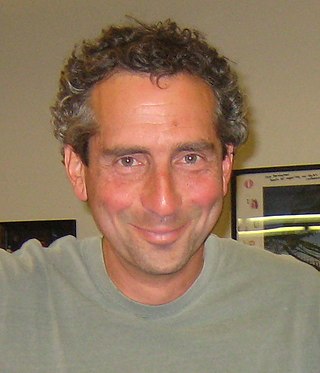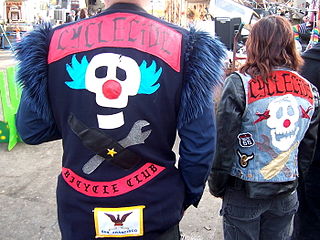Career
Sculpture and public art
Since 2006, Grieve and artistic collaborator Ilana Spector have focused on the construction of highly site-specific public art sculptures using a variety of media. [3] They have worked with museums, governmental agencies, universities, professional races and non-profit organizations, festivals, and companies. [4] [5] [6] In 2009, Grieve was the recipient of a Pollock-Krasner Foundation Grant. [7] [8]
In August 2010, they erected "Cyclisk", a colorful sixty-five foot-high Egyptian-style obelisk made from unusable bicycles parts they had collected, disassembled, cleaned and welded to form an obelisk shape. [9] [10] They collected unusable dump-bound bicycle parts from Trips for Kids/Recyclery in San Rafael, California, Bici Centro in Santa Barbara, California and Community Bikes in Santa Rosa, California. Funded by the City of Santa Rosa's Percent for Art initiative, "Cyclisk" is the largest public art project in the region and stands at the intersection of Santa Rosa Avenue and South A Street in Santa Rosa. [11] [12] [13] [14] [15] [16] [17] [18]
In 2011, Grieve and Spector installed Full Circles, a dynamic constellation of individually-distinct hand-polished steel hoops suspended twenty feet from the dome of the Visitacion Valley Library Branch in San Francisco, California, for the San Francisco Arts Commission. [19]
In 2005 and 2006, Grieve led the Burning Man Temple project, originated by artist David Best. [20] In 2005, he designed and oversaw the construction of the festival's “Temple of Dreams. ” [21] Then, in 2006, he led a team of volunteers to create the "Temple of Hope," named one of the best twelve art pieces at the festival. [22] [23] [24] In 2007, Together with partner Ilana Spector, Grieve created "Bike Arch," aka "Bicycle Arch" aka "Bike Rack" a large scale piece using re-purposed bicycles as a medium. [25] The archway was created from approximately 240 unusable junk bicycle parts headed for the dump from bicycle cooperatives. [26] Soaring over the entrance to Burning Man's Center camp, "Bike Arch" was located in the central area in "Black Rock City" where bikes form the main mode of transportation. The artwork appeared in South Park Season 14, Episode 13, referencing Burning Man as well as the official 2012 London Olympic Opening Ceremonies program to illustrate the sport of cycling. [27] [28]
“THE PIG" was a dinner/happening in the middle of the Black Rock Desert hosted by Grieve and Spector that took place in July 2008. [29] THE PIG was a collaborative artwork – a fourteen-foot sculpture of a fluorescent pink pig standing upon an elaborate art-deco base bestowed with fireworks – accompanied by a seven-course five-star meal for seventy-five people. Submitted before the stock market collapse and 2008 election, this "Salon des Réfusés" brought out each person's relationship to swine – from political (pork-pie politics) to celebratory. The blank Black Rock desert canvas provided a dynamic backdrop for a one-time art-happening barbecue-of-the-ridiculous, crescendoing with the burning of the pig sculpture. Residents of Gerlach, Nevada and guests were invited free of charge to the formal dinner. On a sixty-foot-long white linen traditionally-set table, nationally ranked BBQ chefs provided barbecue. During dessert, the sculpture of the large pink pig, base included, was burned, punctuated by a fireworks display, initiating a three-part performance piece that called attention to culinary, sculptural and performance art. [29]
Act II was called "An Exercise in Democracy – for Under 500 Bucks," in which Grieve and Spector picketed outside the 2008 Burning Man event. In a year the festival's theme was "The American Dream," this performance piece / peaceful protest, brought attention to their grant process. [30] Armed with three 1930s-style picket signs reading "Art on Strike," “B.R.C. LLC HARD ON Art," and "Brush Your Teeth," outside the gate the artists handed out 2000 flyers stating their case for a transparent grant process and treating artists with dignity. [31] In an ironic twist, setting legal precedent, they founded a "Freedom of Speech Zone" directly outside the event. [31] In July 2009, Grieve and Spector returned to the blank Nevada desert with a team of seventy artist collaborators for Act III "Il Mazzolin di Fiori," the finale, a thirty-foot-high "bouquet" of sculptural burnable flowers accompanied by another seven-course meal, this time Italian-themed and mostly vegetarian, topped off with lighting the bouquet of burnable flowers aflame.

Burning Man is a week-long large-scale desert event focused on "community, art, self-expression, and self-reliance" held annually in the western United States. The event's name comes from its culminating ceremony: the symbolic burning of a large wooden effigy, referred to as the Man, that occurs on the penultimate night, the Saturday evening before Labor Day. Since 1991, the event has been at Black Rock City in northwestern Nevada, a temporary city erected in the Black Rock Desert about 100 miles (160 km) north-northeast of Reno. According to Burning Man co-founder Larry Harvey in 2004, the event is guided by ten stated principles: radical inclusion, gifting, decommodification, radical self-reliance, radical self-expression, communal effort, civic responsibility, leaving no trace, participation, and immediacy.
Ruth Doerschuk Dicker was a California painter of landscapes. She primarily lived in New York City, Palo Alto, and Santa Rosa.
David Best is an internationally renowned American sculptor. He is well known for building immense temples out of recycled wood sheets for the Burning Man festivals, where they are then burnt to the ground in a spectacle of light and heat.

Joseph Jacinto Mora was a Uruguayan-born American cowboy, photographer, artist, cartoonist, illustrator, painter, muralist, sculptor, and historian who lived with the Hopi and wrote about his experiences in California. He has been called the "Renaissance Man of the West".

Marco Polo di Suvero, better known as Mark di Suvero, is an abstract expressionist sculptor and 2010 National Medal of Arts recipient.

Ned Kahn is an environmental artist and sculptor, known in particular for museum exhibits, one of which is the Exploratorium in San Francisco. His work usually intends to make an invisible aspect of nature, visible.

Christian Ristow is an American robotic artist. He is known for his robotic performance art under the name Robochrist Industries, his animatronics work in film and television, and his large-scale interactive sculptures.

Robert Carston Arneson was an American sculptor and professor of ceramics in the Art department at University of California, Davis for nearly three decades.

Cyclecide is an American bicycle club based in San Francisco, California, composed of clowns, altered bikes, and a traveling show called "The Bike Rodeo", which is a public performance, and not a bicycle rodeo, a children's bicycle safety clinic.
Roy De Forest was an American painter, sculptor, and teacher. He was involved in both the Funk art and Nut art movements in the Bay Area of California. De Forest's art is known for its quirky and comical fantasy lands filled with bright colors and creatures, most commonly dogs.
Fletcher C. Benton was an American sculptor and painter from San Francisco, California. Benton was widely known for his kinetic art as well as his large-scale steel abstract geometric sculptures.

Robert H. Hudson is an American visual artist. He is known for his funk art assemblage metal sculptures, but he has also worked in painting and printmaking.

The Museum of Sonoma County, commonly known as the Sonoma County Museum, is a non-profit organization located in downtown Santa Rosa, California. Its 7th St. campus comprises the historic 1910 Santa Rosa Post Office, a contemporary art gallery, and a sculpture garden. Between the two buildings, the Museum presents 10-12 rotating exhibitions per year and maintains a permanent collection of over 18,000 objects that document the region's rich history and celebrate local artists. The historic post office is on the National Register of Historic Places.
Squeak Carnwath is a contemporary American painter and arts educator. She is a Professor Emerita of Art at University of California, Berkeley.
James C. Pomeroy was an American artist whose practice spanned a variety of media including performance art, sound art, photography, installation art, sculpture, and video art.
Peter Schifrin is an American Olympic epee fencer and sculptor.

People's Bike Library of Portland, also known as Zoobomb Pyle or simply "the pile", is a 2009 steel and gold leaf sculpture by local artists Brian Borrello and Vanessa Renwick, located in Portland, Oregon, in the United States. It was erected in collaboration with the Zoobomb bicycling collective, and serves as a bicycle parking rack, a "lending library" for weekly bike riders, and a monument to the city's bike culture. The sculpture features a two-story spiral pillar with a gold-plated small bicycle on top; bicycles intended for Zoobomb riders are locked to the pillar and base, which has metal loops serving as hooks.
The Life Cube Project is a community interactive art installation based upon the creator's idea that if you write something down, it is far more likely to happen. The Life Cube installation encourages members of the community and the general public to decorate it with inspirational writing, paintings, drawings, murals, and tapestries for all its visitors to see. Through four iterations at the annual Burning Man festival in 2011, 2012, 2013, and 2015; hundreds of thousands of participants touched, climbed, inscribed, painted, and added their personal visions to the Life Cube. In 2014, the Life Cube Project made its way out of Burning Man and into its first major city in the United States as experiential and interactive art.
Mary Snowden is an American painter and educator. She is known for works that use humor to explore issues of feminist identity and consumerism.
Richard Shaw is an American ceramicist and professor known for his trompe-l'œil style. A term often associated with paintings, referring to the illusion that a two-dimensional surface is three-dimensional. In Shaw's work, it refers to his replication of everyday objects in porcelain. He then glazes these components and groups them in unexpected and even jarring combinations. Interested in how objects can reflect a person or identity, Shaw poses questions regarding the relationship between appearances and reality.








